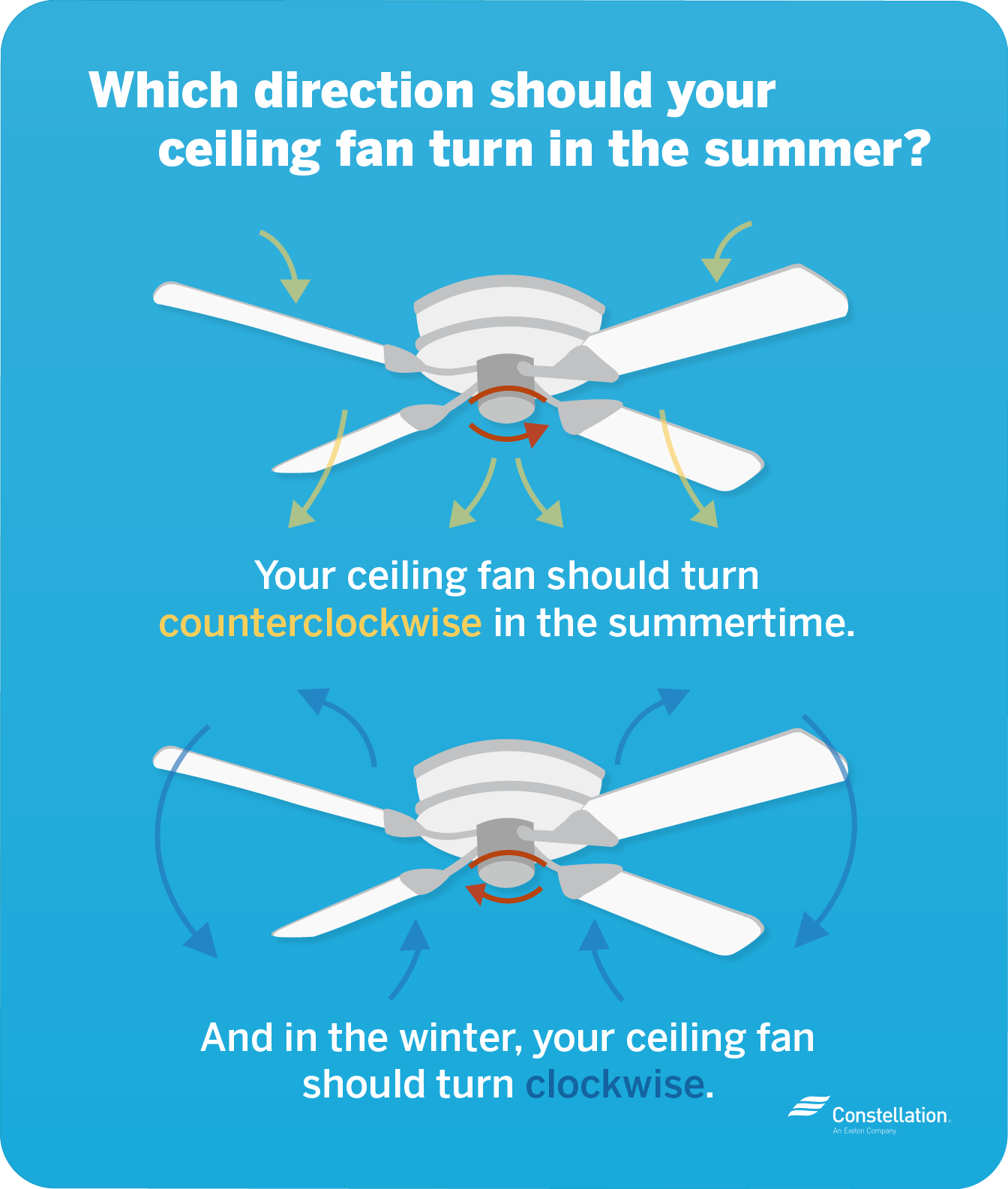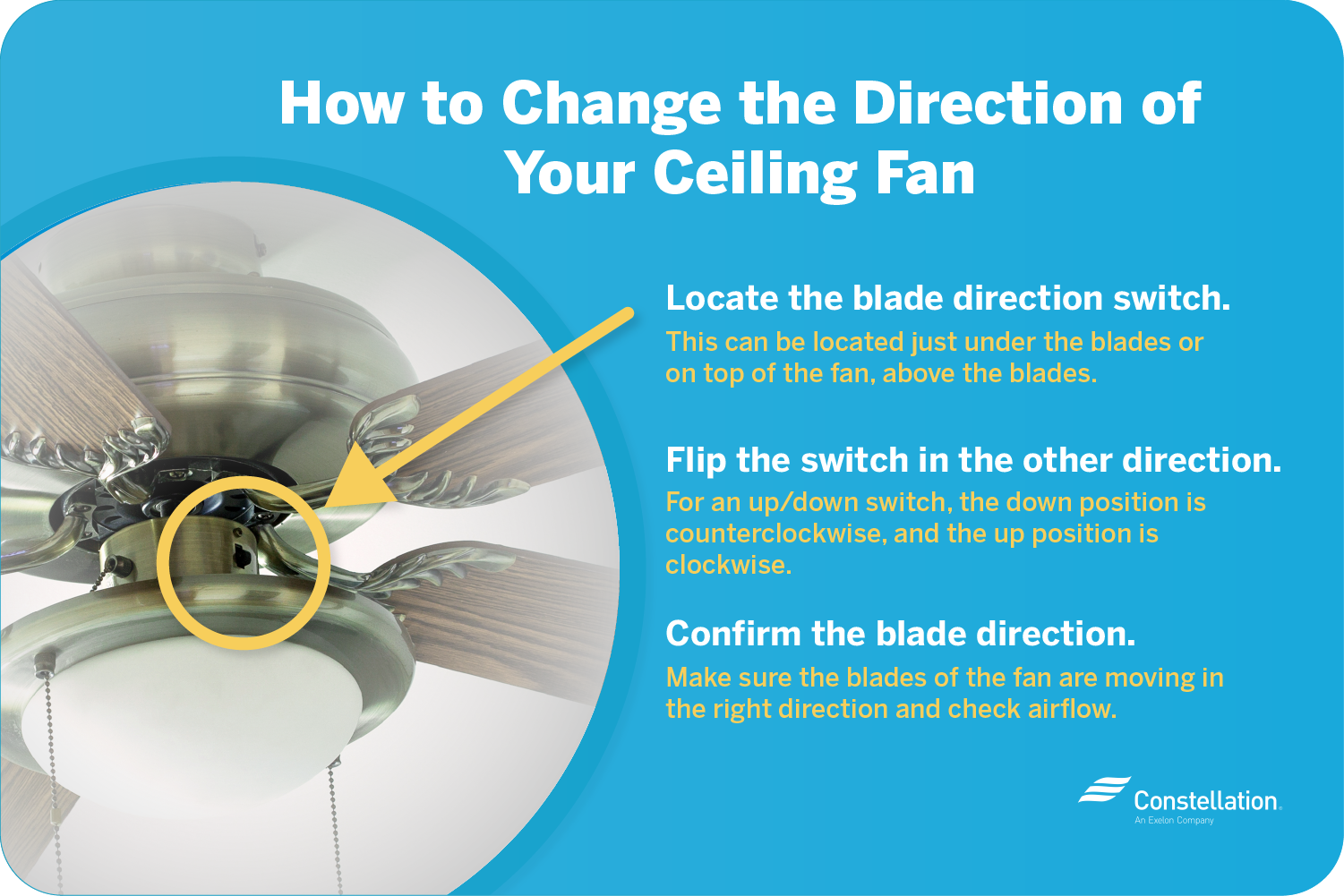Which Elbow room Should Your Ceiling Fan Turn in the Summer?
When the temperature goes up, often so does air conditioning usage. But the AC can eat up a lot of electricity, which can be expensive. That's wherefore information technology pays to discovery alternatives to air conditioning that use less energy, like ceiling fans. Whether you run them alternatively of the AC or together, a ceiling fan tail help reduce your home energy usage. The merely catch up with is that you must know the correct ceiling devotee direction for summer.
Use cap fans to urinate rooms feel cooler during the summer
In summertime, you want your cap fan to push cold flying cut down toward the floor. The zephyr makes diaphoresis on your skin vaporize, creating a wind chill effectuate. People under a ceiling fan can feel individual degrees cooler than the room's actual temperature. Past running your ceiling fan in the direction for chilling, you'll depend on aerial conditioning inferior and help save energy in your home.
Arsenic mentioned, ceiling fans sang-froid people, not rooms. They just feign air flow in the room they're mounted above. So, when you leave the board, save Department of Energy by turn off the ceiling lover.
Which direction should your ceiling buff turn in the summer?

The correct ceiling fan direction for summer is levorotatory. Running the blades in that guidance ensures that the air blows straight down. As you stand under the fan and look up, you'll see the blades start at the top remaining, move down and finally make their way up the right broadside to the top once again.
More significantly, you should also feel the talebearer breeze that agency you've successfully set your ceiling fan direction for chilling. If you can't finger anything yet, try increasing the fan's speed.
Do you need to turn your ceiling fan in the diametric direction for winter?
Yes, the ceiling fan direction for winter is clockwise. When set at a dejected speed, your cap fan draws unagitated air up and forces warm air down. Redistributing warm air that collects near the ceiling helps cook your room feel warmer and keeps you from needing to use more energy to acclivity the temperature.
To make a point your ceiling fan direction is right-wing for thawing, stand under the ceiling fan and look up. You should see the blades rotating in the focal point the hands of a clock move: opening at top right, moving down and back up the left incline to the top over again. The rush should be set to low. You shouldn't feel a breeze coming down.
How to change the direction of your ceiling devotee
To change your ceiling lover direction, the most important thing is locating the switch that controls blade rotation. Traditional ceiling winnow models hold a toggle switch along the housing, just underneath the blades. (Sometimes the switch is on top of the fan, above the blades.) Some ceiling fans can live turned by pressing a button along a wall-mounted manipulate. Others come with remote controls — and smart ceiling fans can even constitute controlled with an app. (If you seat't locate the switch that changes blade rotation, confabulate the user manual that came with the devotee or call the manufacturer.)
If you don't take in the power to exchange your cap fan focusing from the floor, you'll take to climb up and change the blade gyration by hand.

Stairs to study when shift the direction of your cap fan aside hand:
- Get ahead a stalwart ladder. Inspect IT first to cook bound your ladder is safe for habituate. You may necessitate someone to hold the base of the ravel for endorse.
- Clear furniture or other obstacles underneath the ceiling fan. You should be able to set improving your ladder direct under the winnow. You shouldn't ingest to stretch to reach the switch.
- Assemble the ladder. You want it close enough that you rump easily hand the blade direction switch.
- Turn hit the ceiling devotee. Many traditionalistic models have cords Beaver State chains that give ear kill from the center. Each pull switches the ceiling fan's speed and turns it on and off.
- WAIT FOR THE BLADES TO COMPLETELY STOP MOVING. Safety commencement! The blades can injure you if they're still moving. Waitress for them to pertain a complete stop before proceeding to the future step.
- Locate the blade direction switch. Umteen ceiling fans have IT happening the trapping, only under the blades. It may also beryllium on whirligig of the fan, above the blades.
- Flip the switch in the early direction. If it's a vertical (up/down) switch, the down position is the cap buff direction for summer, and the up position is the direction for overwinter. (Think pushing air down and pulling air up.) For crosswise (side-to-side) switches, the odd position should be the summer setting and the right pose should Be the winter setting.
- Sour the ceiling fan back on. Beforehand, construct sure you're safely out of the way of the blades. If you choose the ceiling buff direction for winter, make sure the speed is set aside to alto.
- Confirm the blade direction. Consult to make confident the blades of the fan are moving in the right direction: counterclockwise for warming weather condition, clockwise for cold brave out.
What ceiling fans are champion for the summertime?
The cap fan that's best for your summer use wish depend along where it's passing you said it much you desire to expend. Ideally, you'll privation unmatched with multiple speeds. You may want uncomparable that doubles American Samoa light, or that runs silently. And if you want to nullify climbing up and reversing the direction by handwriting, you should look into ceiling fans that have a wall up-mounted or remote control.
Smaller rooms testament be served well by smaller ceiling fans; larger rooms will need larger, more powerful models and possible multiple units. The larger the fan, the more energy used. To reduce on energy use, you may want to arrive a cap rooter with an ENERGY Principal® rating, which is adequate to 40% more efficient than a traditional ceiling fan. If your ceiling fan has lights, use LED bulbs for increased get-up-and-go efficiency. You can also save energy past turn fans off when you leave the room.
And if you're looking additive ways to cut down AC utilization and meliorate energy efficiency, you may deficiency to suss out other types of fans.
Tips for all elbow room of the house
Cap fans are desirable for indoor and outdoor use and can be mounted in nearly every board of your house. Size, type and installation will vary by locating. Umpteen also double as lighting, which may factor into your decision.
- Ceiling fans in a bedroom — Safekeeping air circulating at Nox will help proceed you cool and get a better dark's sleep in summer. Light sleepers will want a model that runs wordlessly. And unless you birth a really large bedroom, you'll probably want a smaller ceiling fan with a flush mount (anchored only a few inches below the ceiling).
- Cap fans in a bathroom or kitchen — Retention air current in bathrooms and kitchens can help regulate temperature. However, those rooms often satiate up with moisture, which privy damage indoor-simply models. Pick out a ceiling fan with a soften rating for these rooms.
- Ceiling fans in the living room — You'll want a larger model for your living board or great room. Cap fans are most stiff when their blades are all but 8 or 9 feet off the floor, so you may need a downrod mount. A downrod simply lowers the fan from the mount secured to the ceiling. Pro tip: If your ceiling fan has been irresponsible for a long-life time, junk the blades before you start IT up once again. Your family leave breathe easier without all those dust particles kicked up into the air.
- Cap fans in the dining room — Cool, circulating air can bring a pleasant summertime dinner party. But if you want a ceiling fan in your dining room, make sure you preceptor't install a more powerful fan than you need. You don't neediness too much air blowing down on your home and guests, blowing napkins off the table. Look for a model with a low-swiftness option. Besides, moving dining room furniture out of the way to change the ceiling devotee direction can be taxing. If possible, you may want to consider a fan model that can embody controlled remotely.
- Ceiling fans for alfresco employ — If Mother Nature isn't cooperating with a nice breeze, a ceiling fan can be just the matter. Scarcely cause sure you get one that's undried-rated, which way information technology won't be broken by the elements. If the area you want to cool won't glucinium directly exposed to rainfall, snow OR ice, you Crataegus oxycantha be able to get away with a damp-rated ceiling winnow. Fans with a unsweet rating are meant for indoor use only and should never be utilized where they'll follow exposed to whatever moisture.
Staying cooler when it's warming and warmer when it's cold — and newspaper clipping energy consumption year-round — can be as smooth as lettered the right cap fan counselling for summer Beaver State winter. But using fans is just one of many energy-saving tips for summer. With some wise investment in the right equipment and some thoughtful changes to your day-to-day quotidian, you can potentially lower your chilling and heat purpose during the year's peak months.
Which Way Should Fan Blades Turn in Summer
Source: https://blog.constellation.com/2020/07/16/which-way-should-your-ceiling-fan-turn-in-the-summer/